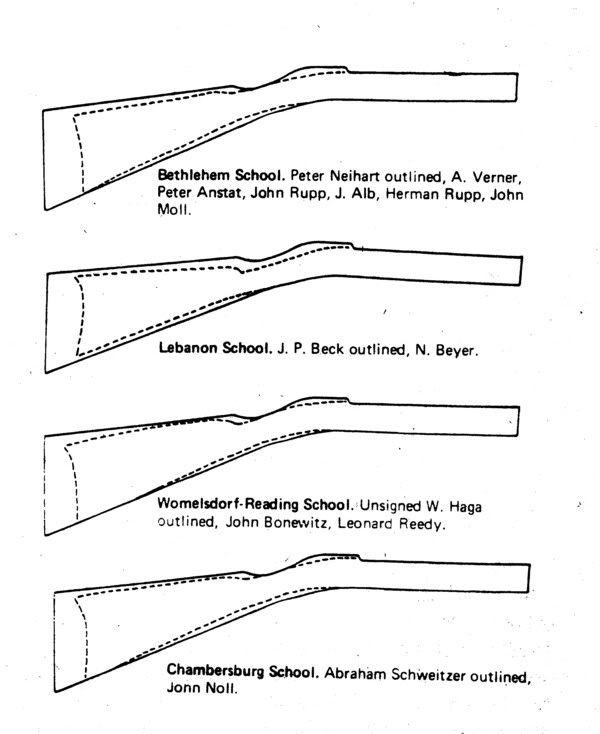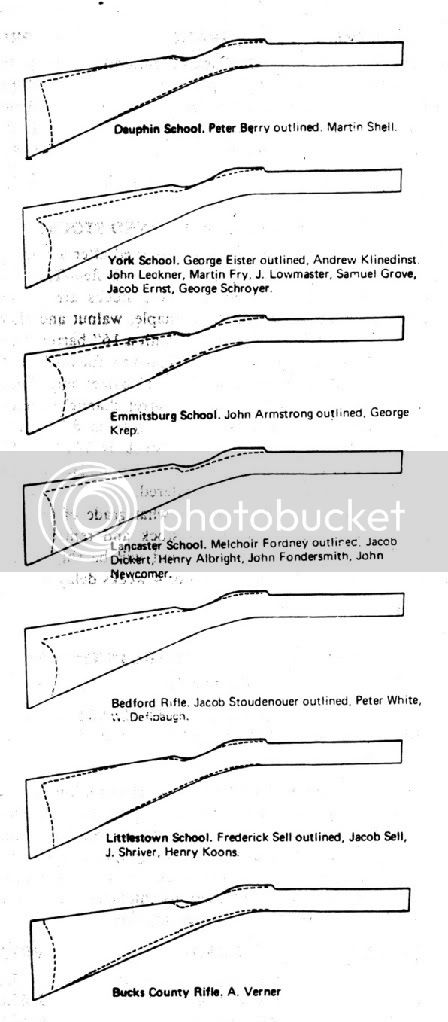Several people have asked about the shapes of the stocks on Pennsylvania (Kentucky) Rifles.
As you may know, the gunsmiths in various regions of Pennsylvania developed different shapes for their stocks. These shapes were often associated with the specific County in which the gunsmith lived and for that reason the name of the County has been used as a method of cataloging various original guns. Often you may hear the term "schools" and it is referring to these Counties stock shapes.
As each gunsmith in a given county had his own likes and dislikes and because there were no Stock Shape Police often a gun will have certain characterstics exaggerated. I know many of the rifles from the Womelsdorf-Reading school have more curvature to the comb than is shown in the picture but these pictures are meant to show the general shapes for the schools.
This is not to say that ALL of the guns from a county looked alike for there were many made which for one reason or the other looked like the style of another County. As these were the days of totally custom guns perhaps someone told the gunsmith he wanted it to look differently, we will never know.
To give you an idea of the differences I have dug out a 1980 Dixie Gun Works Catalog in which they (perhaps Turner Kirkland himself) show a good comparison.
As Dixie sells stock blanks, the shapes are all depicted on the same stock blank outline. From this you can see where and how they depart from the blank. This, for me makes it easier to see just what and where the differences are.
Pay no attention to the curve of the butt plate as this feature changed depending more on the age of the gun, not the County it was made in.
Also given are a few of the names of famous gunsmiths from each County or school.


As you may know, the gunsmiths in various regions of Pennsylvania developed different shapes for their stocks. These shapes were often associated with the specific County in which the gunsmith lived and for that reason the name of the County has been used as a method of cataloging various original guns. Often you may hear the term "schools" and it is referring to these Counties stock shapes.
As each gunsmith in a given county had his own likes and dislikes and because there were no Stock Shape Police often a gun will have certain characterstics exaggerated. I know many of the rifles from the Womelsdorf-Reading school have more curvature to the comb than is shown in the picture but these pictures are meant to show the general shapes for the schools.
This is not to say that ALL of the guns from a county looked alike for there were many made which for one reason or the other looked like the style of another County. As these were the days of totally custom guns perhaps someone told the gunsmith he wanted it to look differently, we will never know.
To give you an idea of the differences I have dug out a 1980 Dixie Gun Works Catalog in which they (perhaps Turner Kirkland himself) show a good comparison.
As Dixie sells stock blanks, the shapes are all depicted on the same stock blank outline. From this you can see where and how they depart from the blank. This, for me makes it easier to see just what and where the differences are.
Pay no attention to the curve of the butt plate as this feature changed depending more on the age of the gun, not the County it was made in.
Also given are a few of the names of famous gunsmiths from each County or school.








